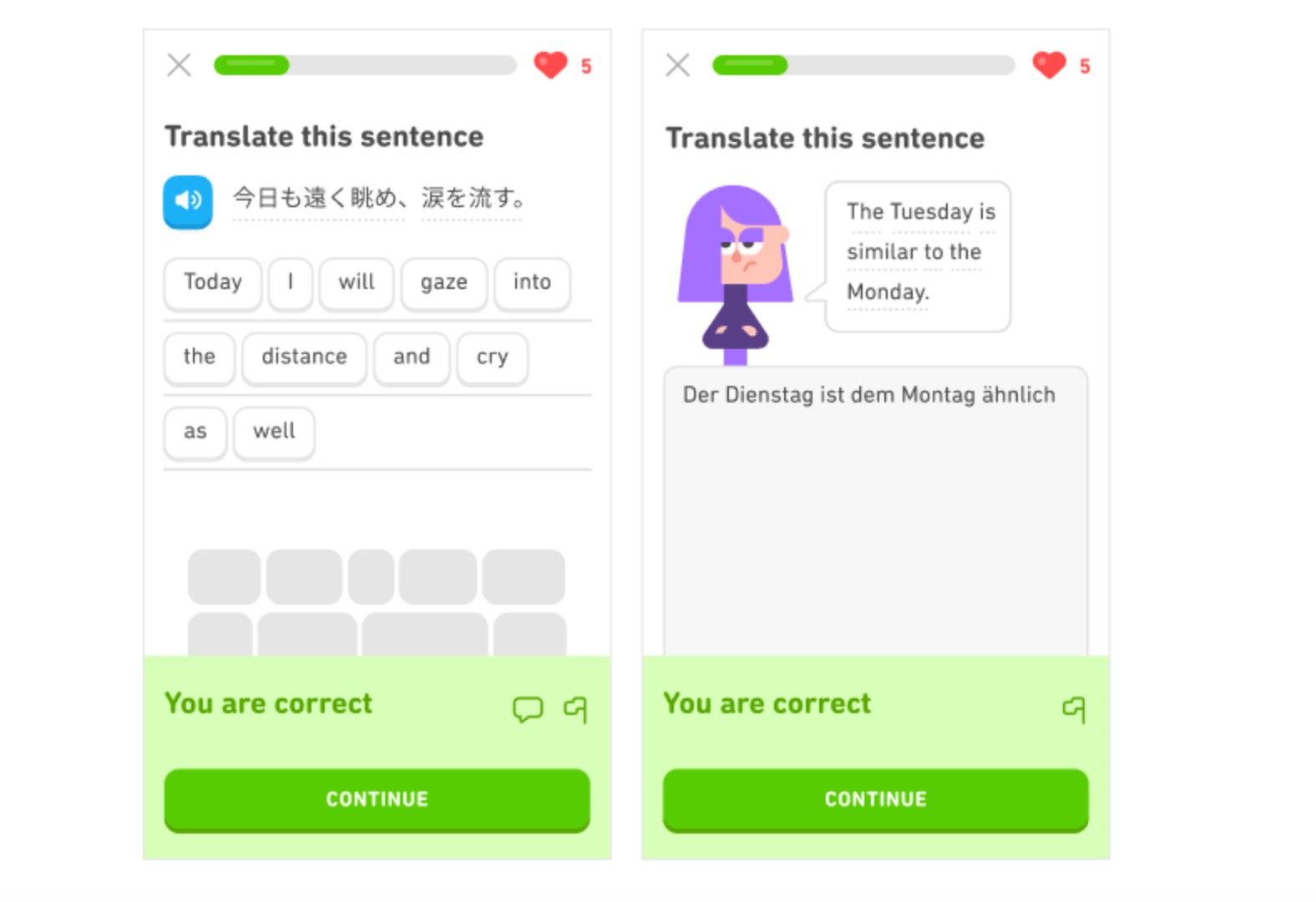Learning Chinese with Duolingo can be a great starting point, but understanding the time commitment is crucial. At LEARNS.EDU.VN, we help you navigate the complexities of language learning, including mastering Mandarin Chinese. The duration to learn Chinese using Duolingo varies significantly depending on your goals, dedication, and supplementary resources like immersion techniques and native speaker practice.
1. What is Duolingo and How Does It Work for Learning Chinese?
Duolingo is a popular language-learning platform that uses a gamified approach to teach various languages, including Chinese (Mandarin). It breaks down the learning process into bite-sized lessons, covering vocabulary, grammar, and pronunciation.
1.1. Key Features of Duolingo’s Chinese Course
- Gamified Lessons: Duolingo uses game-like elements, such as points, levels, and streaks, to motivate learners and make the learning process more engaging.
- Variety of Exercises: The app includes a range of exercises, such as translating sentences, matching words, speaking practice, and listening comprehension.
- Spaced Repetition: Duolingo employs spaced repetition, a technique that presents vocabulary and grammar concepts at increasing intervals to reinforce memory.
- Character Recognition: The Chinese course includes exercises to help learners recognize and write Chinese characters (Hanzi).
- Pronunciation Practice: Duolingo offers pronunciation exercises that allow learners to practice speaking Mandarin and receive feedback on their accuracy.
1.2. Strengths of Using Duolingo to Learn Chinese
- Accessibility: Duolingo is free and accessible on various devices, making it a convenient option for beginners.
- Engaging Format: The gamified approach can make language learning more enjoyable and motivating.
- Basic Vocabulary and Grammar: Duolingo provides a solid foundation in basic Chinese vocabulary and grammar.
- Introduction to Characters: The app introduces learners to Chinese characters, which are essential for reading and writing in Chinese.
1.3. Limitations of Relying Solely on Duolingo
- Lack of Depth: Duolingo’s Chinese course may not provide sufficient depth in grammar and cultural context for advanced learners.
- Artificial Sentences: Some users have reported encountering strange or unnatural sentences in the course, which may not be helpful for real-world communication.
- Limited Speaking Practice: While Duolingo offers some speaking exercises, it may not be enough to develop fluency in spoken Chinese.
- Need for Supplementation: To achieve fluency, learners typically need to supplement Duolingo with other resources, such as textbooks, language partners, and immersion experiences.
2. Factors Influencing the Time to Learn Chinese
Several factors influence how long it takes to learn Chinese with Duolingo or any other method. Understanding these factors can help you set realistic expectations and tailor your learning approach.
2.1. Prior Language Learning Experience
If you have experience learning other languages, especially those with similar grammatical structures or writing systems, you may find it easier to learn Chinese. Familiarity with language learning concepts and strategies can accelerate your progress.
2.2. Time Commitment and Consistency
The amount of time you dedicate to studying Chinese each day or week significantly impacts your learning speed. Consistent, regular study sessions are more effective than sporadic, lengthy ones.
2.3. Learning Style and Strategies
Different people learn in different ways. Some learners benefit from visual aids, while others prefer auditory learning or hands-on practice. Experimenting with various learning strategies can help you find what works best for you.
2.4. Motivation and Goals
Your motivation for learning Chinese and your specific goals (e.g., travel, business, academic study) can influence your dedication and perseverance. Having clear goals can help you stay focused and motivated.
2.5. Use of Supplementary Resources
Relying solely on Duolingo may not be sufficient to achieve fluency. Supplementing your studies with textbooks, language partners, cultural immersion, and other resources can significantly enhance your learning experience.
2.6. Natural Aptitude for Language Learning
Some people have a natural aptitude for language learning, while others may find it more challenging. Recognizing your strengths and weaknesses can help you tailor your learning approach and seek additional support when needed.
3. Estimating the Time Commitment with Duolingo
While it’s impossible to provide an exact timeline, we can offer some estimates based on different levels of proficiency and study habits.
3.1. Achieving Basic Conversational Proficiency (A1-A2)
- Definition: Being able to understand and use simple phrases and sentences, introduce yourself, ask basic questions, and participate in simple conversations.
- Duolingo Focus: Completing the first few sections of the Duolingo Chinese course, focusing on basic vocabulary, grammar, and pronunciation.
- Estimated Time: 150-300 hours of study, which could translate to 6-12 months of consistent effort (30-60 minutes per day).
3.2. Reaching Intermediate Proficiency (B1-B2)
- Definition: Being able to understand and participate in conversations on a wider range of topics, express your opinions, read simple texts, and write short essays.
- Duolingo Focus: Completing a significant portion of the Duolingo Chinese course, including more advanced grammar and vocabulary topics.
- Estimated Time: 400-800 hours of study, which could take 1-3 years of consistent effort (1-2 hours per day), supplemented with other resources.
3.3. Attaining Advanced Proficiency (C1-C2)
- Definition: Being able to understand complex texts, participate in nuanced conversations, express yourself fluently and accurately, and write sophisticated essays.
- Duolingo Focus: Completing the entire Duolingo Chinese course and supplementing it with extensive reading, writing, speaking practice, and cultural immersion.
- Estimated Time: 1000+ hours of study, which could take 3-5 years or more of dedicated effort, including immersion experiences and advanced coursework.
3.4. Sample Study Schedules
| Study Schedule | Daily Study Time | Weekly Study Time | Estimated Time for Basic Proficiency | Estimated Time for Intermediate Proficiency |
|---|---|---|---|---|
| Casual Learner | 30 minutes | 3.5 hours | 9-18 months | 2-4 years |
| Dedicated Learner | 1 hour | 7 hours | 4-9 months | 1-2 years |
| Intensive Learner | 2 hours | 14 hours | 2-4 months | 6-12 months |


4. Enhancing Your Learning Experience Beyond Duolingo
To maximize your progress and achieve fluency in Chinese, consider incorporating these supplementary resources and strategies.
4.1. Textbooks and Workbooks
Using textbooks and workbooks can provide a more structured and in-depth understanding of Chinese grammar and vocabulary. Popular options include the Integrated Chinese series and the New Practical Chinese Reader.
4.2. Language Exchange Partners
Practicing with native speakers is essential for developing fluency and improving your pronunciation. Language exchange platforms like HelloTalk and Tandem connect you with native Chinese speakers who are learning your native language.
4.3. Online Courses and Tutors
Enrolling in online courses or working with a private tutor can provide personalized instruction and feedback. Platforms like Coursera, edX, and iTalki offer a variety of Chinese courses for different levels.
4.4. Immersion and Cultural Exposure
Immersing yourself in the Chinese language and culture can significantly accelerate your learning. This can include traveling to China, watching Chinese movies and TV shows, listening to Chinese music, and attending cultural events.
4.5. Graded Readers and Authentic Materials
Graded readers are books written specifically for language learners, with simplified vocabulary and grammar. As you progress, you can transition to reading authentic materials, such as news articles, blog posts, and novels.
4.6. Flashcard Apps and SRS
Spaced repetition systems (SRS) like Anki and Memrise can help you memorize vocabulary and characters more effectively. These apps use algorithms to present information at optimal intervals, maximizing retention.
5. Focusing on Specific Skills: Speaking, Listening, Reading, and Writing
Each language skill requires different approaches and resources. Tailoring your studies to address your specific needs can help you make faster progress.
5.1. Improving Speaking Skills
- Practice with native speakers: Engage in conversations with native speakers as often as possible.
- Record yourself speaking: Listen to your recordings and identify areas for improvement.
- Use shadowing techniques: Mimic the pronunciation and intonation of native speakers.
- Participate in language exchange events: Attend local language exchange events to practice speaking in a supportive environment.
5.2. Enhancing Listening Comprehension
- Listen to Chinese podcasts and music: Immerse yourself in the sounds of the language.
- Watch Chinese movies and TV shows: Start with subtitles and gradually reduce your reliance on them.
- Take dictation exercises: Listen to short audio clips and write down what you hear.
- Practice active listening: Focus on understanding the main ideas and key details.
5.3. Developing Reading Proficiency
- Start with graded readers: Gradually increase the difficulty level as you progress.
- Use a dictionary or translation tool: Look up unfamiliar words and phrases.
- Read aloud: Practice your pronunciation and intonation while reading.
- Annotate texts: Highlight key vocabulary and grammar points.
5.4. Mastering Writing Skills
- Practice writing characters: Use a character writing app or workbook to learn the correct stroke order.
- Write short essays and journal entries: Express your thoughts and ideas in Chinese.
- Get feedback from native speakers: Ask native speakers to review your writing and provide suggestions for improvement.
- Use online writing tools: Take advantage of online writing tools that offer grammar and vocabulary assistance.
6. Common Challenges and How to Overcome Them
Learning Chinese can be challenging, but understanding common obstacles and strategies for overcoming them can help you stay on track.
6.1. Tone Recognition and Pronunciation
- Challenge: Mastering the four tones of Mandarin Chinese can be difficult for native speakers of languages without tones.
- Solution: Use tone training apps, practice with native speakers, and record yourself speaking.
6.2. Character Memorization
- Challenge: Memorizing thousands of Chinese characters can be daunting.
- Solution: Use flashcard apps, break down characters into smaller components, and practice writing them regularly.
6.3. Grammar Complexity
- Challenge: Chinese grammar can be different from Western languages, particularly in sentence structure and word order.
- Solution: Study grammar rules systematically, practice constructing sentences, and seek feedback from native speakers.
6.4. Lack of Motivation
- Challenge: Maintaining motivation over the long term can be difficult.
- Solution: Set realistic goals, track your progress, reward yourself for achievements, and find a language learning community for support.
6.5. Cultural Differences
- Challenge: Understanding cultural nuances is essential for effective communication.
- Solution: Learn about Chinese culture through books, movies, and interactions with native speakers.
7. The Role of Technology in Accelerating Learning
Technology can be a powerful tool for enhancing your Chinese learning experience.
7.1. Language Learning Apps
- Duolingo: Provides gamified lessons for vocabulary, grammar, and pronunciation.
- Memrise: Uses spaced repetition to help you memorize vocabulary and characters.
- Hello Chinese: Offers comprehensive Chinese courses for beginners.
- ChineseSkill: Focuses on practical conversational skills.
7.2. Dictionaries and Translation Tools
- Pleco: A comprehensive Chinese dictionary with character recognition and audio pronunciation.
- Google Translate: Provides instant translations between Chinese and other languages.
- Baidu Translate: A popular Chinese translation tool.
7.3. Character Writing Apps
- Skritter: Helps you learn to write Chinese characters with stroke order guidance.
- Hanping Chinese Dictionary: Includes character writing animations.
7.4. Online Tutoring Platforms
- iTalki: Connects you with native Chinese tutors for personalized lessons.
- Verbling: Offers online Chinese courses with certified teachers.
7.5. Speech Recognition Software
- Google Assistant: Practice speaking Chinese and get feedback on your pronunciation.
- Siri: Use Siri to practice speaking Chinese commands.
8. Staying Motivated and Consistent
Maintaining motivation is key to long-term success in learning Chinese.
8.1. Setting Realistic Goals
Break down your learning journey into smaller, achievable goals. Celebrate each milestone to stay motivated.
8.2. Tracking Your Progress
Keep a record of your learning activities and achievements. Seeing your progress can boost your confidence.
8.3. Finding a Language Learning Community
Join a language learning community online or in person. Sharing your experiences with others can provide support and encouragement.
8.4. Rewarding Yourself
Reward yourself for reaching your goals. This can be anything from treating yourself to a nice meal to taking a weekend trip.
8.5. Making it Fun
Find ways to make learning Chinese enjoyable. This could involve watching your favorite movies in Chinese, listening to Chinese music, or cooking Chinese food.
9. Real-Life Applications and Benefits of Learning Chinese
Understanding the practical benefits of learning Chinese can provide additional motivation.
9.1. Career Opportunities
China is a major economic power, and Mandarin Chinese is becoming increasingly valuable in the global job market.
9.2. Travel and Cultural Experiences
Knowing Chinese can enhance your travel experiences in China and other parts of the world.
9.3. Cognitive Benefits
Learning a new language has been shown to improve cognitive function, memory, and problem-solving skills.
9.4. Personal Enrichment
Learning Chinese can broaden your horizons, deepen your understanding of the world, and connect you with a rich and ancient culture.
10. Case Studies: Successful Duolingo Learners
While Duolingo alone may not guarantee fluency, it can be a valuable tool when combined with other resources.
10.1. Case Study 1: Maria’s Journey
Maria, a college student, used Duolingo to build a foundation in Chinese before studying abroad in Beijing. She found that Duolingo helped her learn basic vocabulary and grammar, which made it easier to follow her classes in China.
10.2. Case Study 2: David’s Experience
David, a business professional, used Duolingo to learn conversational Chinese for his work trips to Shanghai. He supplemented Duolingo with language exchange sessions and found that he could communicate more effectively with his Chinese colleagues.
10.3. Case Study 3: Emily’s Success
Emily, a retiree, used Duolingo to learn Chinese as a hobby. She enjoyed the gamified format and found that it kept her engaged and motivated. She also joined a local Chinese cultural club to practice her speaking skills.
11. Advanced Strategies for Fluency
Once you have a solid foundation in Chinese, you can use these advanced strategies to achieve fluency.
11.1. Shadowing
Listen to native speakers and repeat what they say, mimicking their pronunciation and intonation.
11.2. Sentence Mining
Collect useful sentences from authentic materials and use them in your own conversations.
11.3. Immersion
Surround yourself with the Chinese language as much as possible.
11.4. Extensive Reading
Read a lot of Chinese texts, even if you don’t understand every word.
11.5. Active Recall
Test yourself regularly on what you have learned.
12. Expert Opinions on Language Learning with Apps
Experts have mixed opinions on the effectiveness of language learning apps like Duolingo.
12.1. Pros
- Accessibility: Apps make language learning more accessible to a wider audience.
- Engagement: Gamified formats can make learning more engaging and fun.
- Convenience: Apps allow you to study anytime, anywhere.
12.2. Cons
- Lack of Depth: Apps may not provide sufficient depth in grammar and cultural context.
- Artificial Sentences: Some apps use unnatural sentences that may not be helpful for real-world communication.
- Limited Speaking Practice: Apps may not offer enough opportunities for speaking practice.
13. Resources Available at LEARNS.EDU.VN
At LEARNS.EDU.VN, we offer a variety of resources to help you learn Chinese effectively.
13.1. Comprehensive Chinese Courses
We offer comprehensive Chinese courses for learners of all levels, from beginner to advanced.
13.2. Expert Tutors
Our experienced tutors provide personalized instruction and feedback.
13.3. Interactive Learning Materials
We offer interactive learning materials, including videos, audio recordings, and quizzes.
13.4. Language Exchange Programs
We connect you with native Chinese speakers for language exchange sessions.
13.5. Cultural Immersion Events
We organize cultural immersion events to help you learn about Chinese culture.
14. FAQ About Learning Chinese with Duolingo
14.1. Is Duolingo enough to become fluent in Chinese?
No, Duolingo can provide a good foundation, but fluency requires additional resources and practice.
14.2. How long does it take to complete the Duolingo Chinese course?
It depends on your study habits, but it typically takes several months to a year.
14.3. What are the best supplementary resources for learning Chinese?
Textbooks, language exchange partners, online courses, and immersion experiences are all valuable.
14.4. How can I improve my Chinese pronunciation?
Practice with native speakers, use tone training apps, and record yourself speaking.
14.5. How can I memorize Chinese characters effectively?
Use flashcard apps, break down characters into smaller components, and practice writing them regularly.
14.6. What are the most common challenges in learning Chinese?
Tone recognition, character memorization, and grammar complexity are common challenges.
14.7. How can I stay motivated while learning Chinese?
Set realistic goals, track your progress, and find a language learning community.
14.8. What are the career benefits of learning Chinese?
Knowing Chinese can open up career opportunities in various fields, including business, translation, and education.
14.9. How can I immerse myself in Chinese culture?
Travel to China, watch Chinese movies, listen to Chinese music, and attend cultural events.
14.10. What are some advanced strategies for achieving fluency in Chinese?
Shadowing, sentence mining, immersion, extensive reading, and active recall are all effective strategies.
15. Conclusion: Your Path to Mandarin Fluency
Learning Chinese with Duolingo can be a great first step, but achieving fluency requires dedication, consistency, and the use of supplementary resources. By understanding the factors that influence learning speed, setting realistic goals, and incorporating effective strategies, you can successfully navigate your path to Mandarin fluency. Remember, LEARNS.EDU.VN is here to support you every step of the way, with comprehensive courses, expert tutors, and a wealth of resources to help you achieve your language learning goals. Unlock your potential and embrace the journey of mastering Mandarin Chinese with LEARNS.EDU.VN!
Ready to take your Chinese learning to the next level? Visit LEARNS.EDU.VN today to explore our comprehensive Chinese courses, connect with expert tutors, and access a wealth of resources to help you achieve fluency. Whether you’re a beginner or an advanced learner, we have the tools and support you need to succeed. Don’t wait, start your journey to Mandarin mastery with LEARNS.EDU.VN today!
Contact Information:
Address: 123 Education Way, Learnville, CA 90210, United States
Whatsapp: +1 555-555-1212
Website: learns.edu.vn
